Railways of Ceylon and the old world – Compiled by Raj Gonsalkorale
Information and photographs sourced from the Wikipedia
The Sri Lanka Railway, originally known as Ceylon Government Railways, was conceived in the 1850s and service began in 1864 with the construction of the main line from Colombo to Ambepussa, 54 kilometers to the east. The Railway was initially built in Ceylon with the intension of transportation of Tea and Coffee from hill country to Colombo.
For many years, transporting such goods was the main purpose and the source of income on the line. With time and population growth, however, passenger traffic increased. In the 1960s, passenger traffic overtook freight as the main source of revenue.
The railway is now primarily engaged in the transport of passengers, especially commuters to and from Colombo, thereby reducing road congestion.
The first train that ran on 27 December 1864, was officially opened for traffic on 02 October 1865. The train was extended in stages with service to Kandy in 1867, to Nawalapitiya in 1874, to Nanu-Oya in 1885, to Bandarawela in 1894, and to Badulla in 1924.
Other lines were completed in due course to link the country: the Matale Line in 1880, the Coast Line in 1895, the Northern Line in 1905, the Mannar Line in 1914, the Kelani Valley Line in 1919, the Puttalam Line in 1926, and the Batticaloa and Trincomalee Lines in 1928. Thereafter, no major extends were added to the Sri Lankan (Ceylon) Railway Routes as the British left the country for native rule. Until 1953, Sri Lankan Railway served with steam locomotives and enhanced its service to more power with diesel locomotives. Various types of diesel locomotives were added to the service.
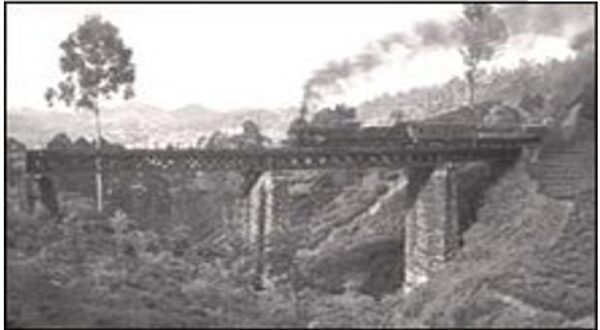
1880 steam-powered train on the hill-country Colombo-Badulla line
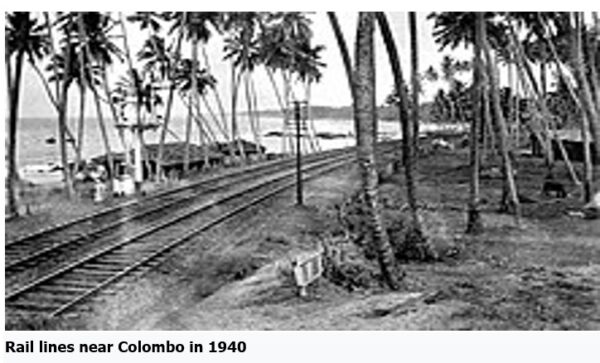
Sri Lanka Railway Network
The Railway network comprises nine lines radiating from Colombo, which connect most major population and industrial centres. The photographs shown below, sourced from Wikipedia, shows the hard work that would have gone into when the train lines were being built.
The Main Line starts from Colombo and runs east and north past the rapidly developing centers of Ragama, Gampaha, Veyangoda, and Polgahawela. At Rambukkana, the Main Line begins its steep climb into the hills of the upcountry. Between Balana and Kadugannawa, the track clings to the side of sheer cliffs, offering passengers spectacular views of Batalegala (‘Bible’ Rock). The Main Line then continues its climb through the scenic tea country, connecting busy local market centers at Gampola, Nawalapitiya, and Hatton before reaching Nanu-Oya. This is the connection to the former colonial resort of Nuwara-Eliya, which is still popular because of its temperate climate, its many classic hotels, and its British-style gardens. The Main Line continues its ascent to the summit at Pattipola, 6,226 feet above sea level, before descending past Bandarawela to Badulla. In the upcountry, passengers are rewarded with delightful views of tea gardens, mountains and valleys, cascading torrents and waterfalls.
The Matale Line branches off the Main Line at Peradeniya Junction, near the world-famous Peradeniya Botanical Gardens. It connects to Kandy, home of the Śrī Dalada Maligawa, which houses the Sacred Tooth Relic of the Lord Buddha, before descending to Matale.
The Coast Line runs south from Colombo, following the edge of the Indian Ocean, and offering passengers views of tropical beaches and coconut palms. This line links the regional towns of Moratuwa, Panadura, and Kalutara South, as well as popular beach resorts at Aluthgama, Ambalangoda, and Hikkaduwa. The line continues past Galle, which is famous for its historic and well-preserved Dutch Fort, before terminating at Matara.
The Kelani Valley Line extends from Colombo south and east to Avissawella. This was originally built as a narrow gauge line and was converted to dual gauge between 1991 and 1997.
The Puttalam Line branches off the Main Line at Ragama, extends north past Negombo, an important regional town and tourist centre, and links other busy market towns and fishing villages.
The Northern Line branches northward from the Main Line at Polgahawela, passing Kurunegala, the capital of Wayamba Province, before continuing to the historic cultural and religious centre of Anuradhapura. This city was established in the 4th century B.C. and contains many sites of religious and archaeological interest. Service is now curtailed beyond Vavuniya and on the Mannar Line.
The Batticaloa Line branches eastward from the Northern Line at Maho, to Polonnaruwa, site of an ancient capital in the 11th century and home to many historic monuments.
The Trincomalee Line branches north and east from the Batticaloa Line at Gal-Oya Junction and extends to Trincomalee.
Historical photographs showing the hard work that had to be endured in constructing the Rail tracks
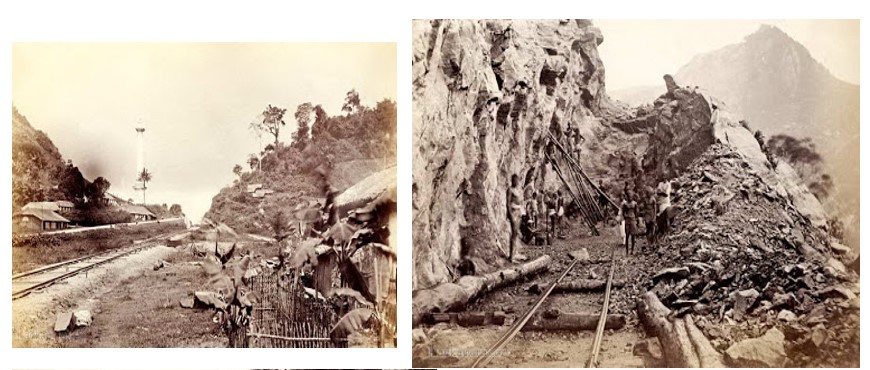
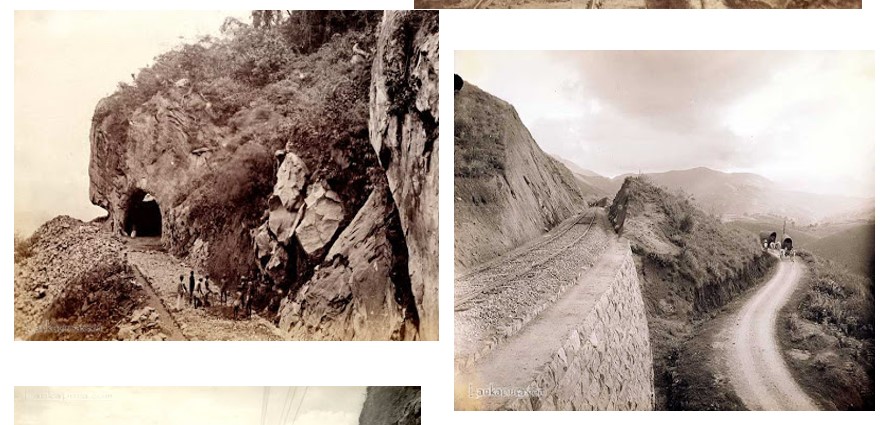
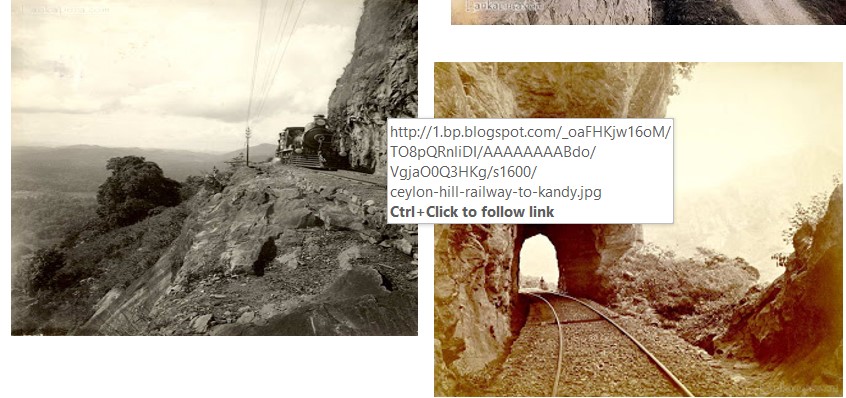
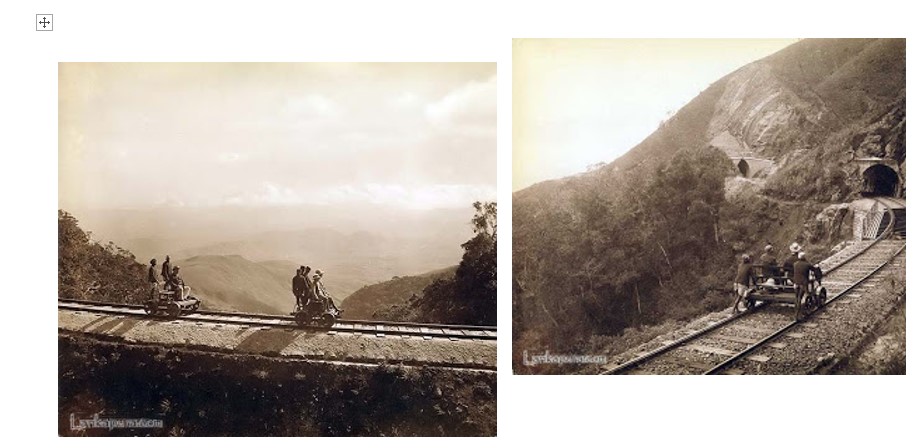
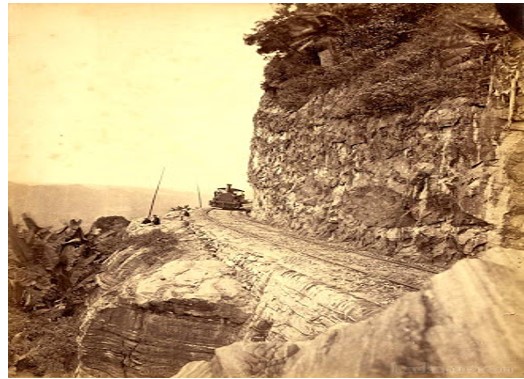
Ancient systems
The Post Track, a prehistoric causeway in the valley of the River Brue in the Somerset Levels, England, is one of the oldest known constructed trackways and dates from around 3838 BCE, making it some 30 years older than the Sweet Track from the same area.[2] Various sections have been scheduled as ancient monuments.[3][4][5][6]
Evidence indicates that there was a 6 to 8.5 km long Diolkos paved trackway, which transported boats across the Isthmus of Corinth in Greece from around 600 BC. Wheeled vehicles pulled by men and animals ran in grooves in limestone, which provided the track element, preventing the wagons from leaving the intended route. The Diolkos was in use for over 650 years, until at least the 1st century AD. Paved trackways were also later built in Roman Egypt.
In China, a railway has been discovered in south west Henan province near Nanyang city. It was carbon dated to be about 2200 years ago from Qin dynasty. The rails are made from hard wood and treated against corrosion while the sleepers or railway ties made from wood that were not treated and therefore have rotted. Qin railway sleeper was designed to allow horses to gallop through which would go to the next rail station which would then be swapped for a fresh horse. The railway is theorized to have been used for transportation of goods to the front line troops and to fix the Great Wall.
Pre-steam
Wooden rails introduced
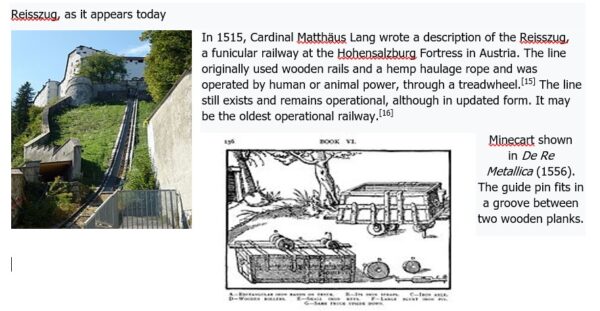
Wagonways (or tramways), with wooden rails and horse-drawn traffic, are known to have been used in the 1550s to facilitate transportation of ore tubs to and from mines. They soon became popular in Europe and an example of their operation was illustrated by Georgius Agricola (see image) in his 1556 work De re metallica. This line used “Hund” carts with unflanged wheels running on wooden planks and a vertical pin on the truck fitting into the gap between the planks to keep it going the right way. The miners called the wagons Hunde (“dogs”) from the noise they made on the tracks. There are many references to wagonways in central Europe in the 16th century
A wagonway was introduced to England by German miners at Caldbeck, Cumbria, possibly in the 1560s. A wagonway was built at Prescot, near Liverpool, sometime around 1600, possibly as early as 1594. Owned by Philip Layton, the line carried coal from a pit near Prescot Hall to a terminus about half a mile away.[21] A funicular railway was made at Broseley in Shropshire some time before 1604. This carried coal for James Clifford from his mines down to the river Severn to be loaded onto barges and carried to riverside towns. The Wollaton Wagonway, completed in 1604 by Huntingdon Beaumont, has sometimes erroneously been cited as the earliest British railway. It ran from Strelley to Wollaton near Nottingham.
The Middleton Railway in Leeds, which was built in 1758, later became the world’s oldest operational railway (other than funiculars), albeit now in an upgraded form. In 1764, the first railway in America was built in Lewiston, New York.
Metal rails introduced
The introduction of steam engines for powering blast air to blast furnaces led to a large increase in British iron production after the mid 1750s
In the late 1760s, the Coalbrookdale Company began to fix plates of cast iron to the upper surface of wooden rails, which increased their durability and load-bearing ability. At first only balloon loops could be used for turning wagons, but later, movable points were introduced that allowed passing loops to be created
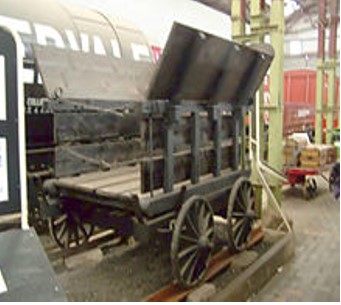
A replica of a “Little Eaton Tramway” wagon, the tracks are plateways.
A system was introduced in which unflanged wheels ran on L-shaped metal plates – these became known as plateways. John Curr, a Sheffield colliery manager, invented this flanged rail in 1787, though the exact date of this is disputed[who?]. The plate rail was taken up by Benjamin Outram for wagonways serving his canals, manufacturing them at his Butterley ironworks. In 1803, William Jessop opened the Surrey Iron Railway, a double track plateway, sometimes erroneously cited as world’s first public railway, in south London.
Cast iron fishbelly edge rail manufactured by Outram at the Butterley Company ironworks for the Cromford and High Peak Railway (1831). These are smooth edgerails for wheels with flanges.
In 1789, William Jessop had introduced a form of all-iron edge rail and flanged wheels for an extension to the Charnwood Forest Canal at Nanpantan, Loughborough, Leicestershire. In 1790, Jessop and his partner Outram began to manufacture edge-rails. Jessop became a partner in the Butterley Company in 1790. The first public edgeway (thus also first public railway) built was the Lake Lock Rail Road in 1796. Although the primary purpose of the line was to carry coal, it also carried passengers.
These two systems of constructing iron railways, the “L” plate-rail and the smooth edge-rail, continued to exist side by side into the early 19th century. The flanged wheel and edge-rail eventually proved its superiority and became the standard for railways.
Cast iron was not a satisfactory material for rails because it was brittle and broke under heavy loads. The wrought iron rail, invented by John Birkinshaw in 1820, solved these problems. Wrought iron (usually simply referred to as “iron”) was a ductile material that could undergo considerable deformation before breaking, making it more suitable for iron rails. But wrought iron was expensive to produce until Henry Cort patented the puddling process in 1784. In 1783, Cort also patented the rolling process, which was 15 times faster at consolidating and shaping iron than hammering.[28] These processes greatly lowered the cost of producing iron and iron rails. The next important development in iron production was hot blast developed by James Beaumont Neilson (patented 1828), which considerably reduced the amount of coke (fuel) or charcoal needed to produce pig iron.[29] Wrought iron was a soft material that contained slag or dross. The softness and dross tended to make iron rails distort and delaminate and they typically lasted less than 10 years in use, and sometimes as little as one year under high traffic. All these developments in the production of iron eventually led to replacement of composite wood/iron rails with superior all-iron rails.
The introduction of the Bessemer process, enabling steel to be made inexpensively, led to the era of great expansion of railways that began in the late 1860s. Steel rails lasted several times longer than iron.[30][31][32] Steel rails made heavier locomotives possible, allowing for longer trains and improving the productivity of railroads.[33] The Bessemer process introduced nitrogen into the steel, which caused the steel to become brittle with age. The open hearth furnace began to replace the Bessemer process near the end of 19th century, improving the quality of steel and further reducing costs. Steel completely replaced the use of iron in rails, becoming standard for all railways.
Steam power introduced
James Watt, a British inventor and mechanical engineer, greatly improved the steam engine of Thomas Newcomen, hitherto used to pump water out of mines. Watt developed a reciprocating engine in 1769, capable of powering a wheel. Although the Watt engine powered cotton mills and a variety of machinery, it was a large stationary engine. It could not be otherwise: the state of boiler technology necessitated the use of low pressure steam acting upon a vacuum in the cylinder; this required a separate condenser and an air pump. Nevertheless, as the construction of boilers improved, Watt investigated the use of high-pressure steam acting directly upon a piston. This raised the possibility of a smaller engine, that might be used to power a vehicle and he patented a design for a steam locomotive in 1784. His employee William Murdoch produced a working model of a self-propelled steam carriage in that year.
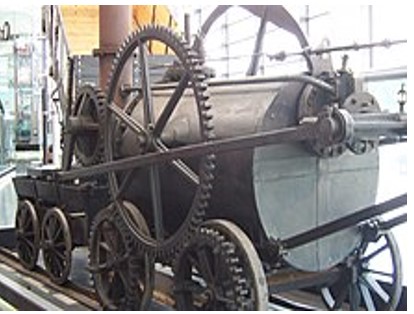
A replica of Trevithick’s engine at the National Waterfront Museum, Swansea
The first full-scale working railway steam locomotive was built in the United Kingdom in 1804 by Richard Trevithick, a British engineer born in Cornwall. This used high-pressure steam to drive the engine by one power stroke. The transmission system employed a large flywheel to even out the action of the piston rod. On 21 February 1804, the world’s first steam-powered railway journey took place when Trevithick’s unnamed steam locomotive hauled a train along the tramway of the Penydarren ironworks, near Merthyr Tydfil in South Wales.Trevithick later demonstrated a locomotive operating upon a piece of circular rail track in Bloomsbury, London, the Catch Me Who Can, but never got beyond the experimental stage with railway locomotives, not least because his engines were too heavy for the cast-iron plateway track then in use.
The first commercially successful steam locomotive was Matthew Murray‘s rack locomotive Salamanca built for the Middleton Railway in Leeds in 1812. This twin-cylinder locomotive was not heavy enough to break the edge-rails track and solved the problem of adhesion by a cog-wheel using teeth cast on the side of one of the rails. Thus it was also the first rack railway.
This was followed in 1813 by the locomotive Puffing Billy built by Christopher Blackett and William Hedley for the Wylam Colliery Railway, the first successful locomotive running by adhesion only. This was accomplished by the distribution of weight between a number of wheels. Puffing Billy is now on display in the Science Museum in London, making it the oldest locomotive in existence.
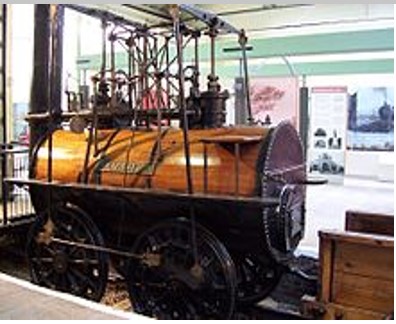
The Locomotion at Darlington Railway Centre and Museum
In 1814, George Stephenson, inspired by the early locomotives of Trevithick, Murray and Hedley, persuaded the manager of the Killingworth colliery where he worked to allow him to build a steam-powered machine. Stephenson played a pivotal role in the development and widespread adoption of the steam locomotive. His designs considerably improved on the work of the earlier pioneers. He built the locomotive Blücher, also a successful flanged-wheel adhesion locomotive. In 1825, he built the locomotive Locomotion for the Stockton and Darlington Railway in the north east of England, which became the first public steam railway in the world, although it used both horse power and steam power on different runs. In 1829, he built the locomotive Rocket, which entered in and won the Rainhill Trials. This success led to Stephenson establishing his company as the pre-eminent builder of steam locomotives for railways in Great Britain and Ireland, the United States, and much of Europe.[39]:24–30[40] The first public railway which used only steam locomotives, all the time, was Liverpool and Manchester Railway, built in 1830.
Steam power continued to be the dominant power system in railways around the world for more than a century.
Electric power introduced
The first known electric locomotive was built in 1837 by chemist Robert Davidson of Aberdeen in Scotland, and it was powered by galvanic cells (batteries). Thus it was also the earliest battery electric locomotive. Davidson later built a larger locomotive named Galvani, exhibited at the Royal Scottish Society of Arts Exhibition in 1841. The seven-ton vehicle had two direct-drive reluctance motors, with fixed electromagnets acting on iron bars attached to a wooden cylinder on each axle, and simple commutators.
It hauled a load of six tons at four miles per hour (6 kilometers per hour) for a distance of one and a half miles (2.4 kilometres). It was tested on the Edinburgh and Glasgow Railway in September of the following year, but the limited power from batteries prevented its general use. It was destroyed by railway workers, who saw it as a threat to their job security.

Lichterfelde tram, 1882
Werner von Siemens demonstrated an electric railway in 1879 in Berlin. The world’s first electric tram line, Gross-Lichterfelde Tramway, opened in Lichterfelde near Berlin, Germany, in 1881. It was built by Siemens. The tram ran on 180 Volt DC, which was supplied by running rails. In 1891 the track was equipped with an overhead wire and the line was extended to Berlin-Lichterfelde West station. The Volk’s Electric Railway opened in 1883 in Brighton, England. The railway is still operational, thus making it the oldest operational electric railway in the world. Also in 1883, Mödling and Hinterbrühl Tram opened near Vienna in Austria. It was the first tram line in the world in regular service powered from an overhead line. Five years later, in the US electric trolleys were pioneered in 1888 on the Richmond Union Passenger Railway, using equipment designed by Frank J. Sprague.
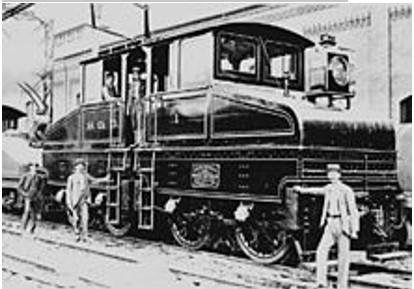
Baltimore & Ohio electric engine
The first use of electrification on a main line was on a four-mile stretch of the Baltimore Belt Line of the Baltimore and Ohio Railroad (B&O) in 1895 connecting the main portion of the B&O to the new line to New York through a series of tunnels around the edges of Baltimore’s downtown.
Electricity quickly became the power supply of choice for subways, abetted by the Sprague’s invention of multiple-unit train control in 1897. By the early 1900s, most street railways were electrified.
The first practical AC electric locomotive was designed by Charles Brown, then working for Oerlikon, Zürich. In 1891, Brown had demonstrated long-distance power transmission, using three-phase AC, between a hydro-electric plant at Lauffen am Neckar and Frankfurt am Main West, a distance of 280 km. Using experience he had gained while working for Jean Heilmann on steam-electric locomotive designs, Brown observed that three-phase motors had a higher power-to-weight ratio than DC motors and, because of the absence of a commutator, were simpler to manufacture and maintain.[45] However, they were much larger than the DC motors of the time and could not be mounted in underfloor bogies: they could only be carried within locomotive bodies.[46]
In 1894, Hungarian engineer Kálmán Kandó developed a new type 3-phase asynchronous electric drive motors and generators for electric locomotives. Kandó’s early 1894 designs were first applied in a short three-phase AC tramway in Evian-les-Bains (France), which was constructed between 1896 and 1898.[47][48][49][50][51]
In 1896, Oerlikon installed the first commercial example of the system on the Lugano Tramway. Each 30-tonne locomotive had two 110 kW (150 hp) motors run by three-phase 750 V 40 Hz fed from double overhead lines. Three-phase motors run at constant speed and provide regenerative braking, and are well suited to steeply graded routes, and the first main-line three-phase locomotives were supplied by Brown (by then in partnership with Walter Boveri) in 1899 on the 40 km Burgdorf—Thun line, Switzerland.
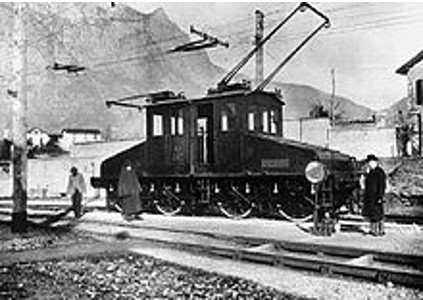
A prototype of a Ganz AC electric locomotive in Valtellina, Italy, 1901
Italian railways were the first in the world to introduce electric traction for the entire length of a main line rather than just a short stretch. The 106 km Valtellina line was opened on 4 September 1902, designed by Kandó and a team from the Ganz works.[52][53] The electrical system was three-phase at 3 kV 15 Hz. In 1918,[54] Kandó invented and developed the rotary phase converter, enabling electric locomotives to use three-phase motors whilst supplied via a single overhead wire, carrying the simple industrial frequency (50 Hz) single phase AC of the high voltage national networks.[53]
An important contribution to the wider adoption of AC traction came from SNCF of France after World War II. The company conducted trials at 50 Hz, and established it as a standard. Following SNCF’s successful trials, 50 Hz (now also called industrial frequency) was adopted as standard for main lines across the world.[55]
Diesel power introduced
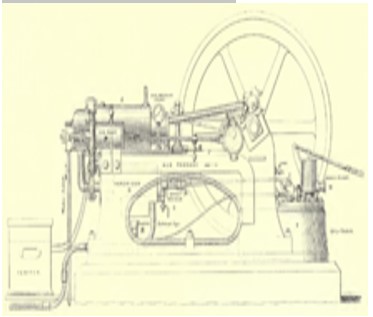
Diagram of Priestman Oil Engine from The Steam engine and gas and oil engines (1900) by John Perry
Earliest recorded examples of an internal combustion engine for railway use included a prototype designed by William Dent Priestman, which was examined by Sir William Thomson in 1888 who described it as a “[Priestman oil engine] mounted upon a truck which is worked on a temporary line of rails to show the adaptation of a petroleum engine for locomotive purposes.”.[56][57] In 1894, a 20 hp (15 kW) two axle machine built by Priestman Brothers was used on the Hull Docks.[58]
In 1906, Rudolf Diesel, Adolf Klose and the steam and diesel engine manufacturer Gebrüder Sulzer founded Diesel-Sulzer-Klose GmbH to manufacture diesel-powered locomotives. Sulzer had been manufacturing diesel engines since 1898. The Prussian State Railways ordered a diesel locomotive from the company in 1909. The world’s first diesel-powered locomotive was operated in the summer of 1912 on the Winterthur–Romanshorn railway in Switzerland, but was not a commercial success.[59] The locomotive weight was 95 tonnes and the power was 883 kW with a maximum speed of 100 km/h.[60] Small numbers of prototype diesel locomotives were produced in a number of countries through the mid-1920s.
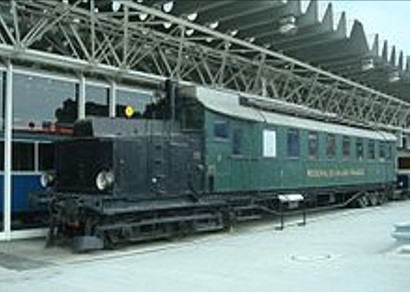
Swiss & German co-production: world’s first functional diesel–electric railcar 1914
A significant breakthrough occurred in 1914, when Hermann Lemp, a General Electric electrical engineer, developed and patented a reliable direct current electrical control system (subsequent improvements were also patented by Lemp).[61] Lemp’s design used a single lever to control both engine and generator in a coordinated fashion, and was the prototype for all diesel–electric locomotive control systems. In 1914, world’s first functional diesel–electric railcars were produced for the Königlich-Sächsische Staatseisenbahnen (Royal Saxon State Railways) by Waggonfabrik Rastatt with electric equipment from Brown, Boveri & Cie and diesel engines from Swiss Sulzer AG.
They were classified as DET 1 and DET 2 [de]. The first regular use of diesel–electric locomotives was in switching (shunter) applications. General Electric produced several small switching locomotives in the 1930s (the famous “44-tonner” switcher was introduced in 1940) Westinghouse Electric and Baldwin collaborated to build switching locomotives starting in 1929.
In 1929, the Canadian National Railways became the first North American railway to use diesels in mainline service with two units, 9000 and 9001, from Westinghouse.[62]
High-speed rail
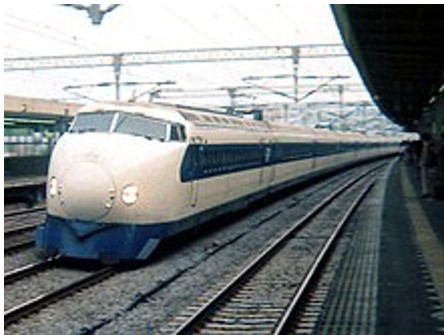
0-Series Shinkansen, introduced in 1964, triggered the intercity train travel boom.
The first electrified high-speed rail Tōkaidō Shinkansen (series 0) was introduced in 1964 between Tokyo and Osaka in Japan. Since then high-speed rail transport, functioning at speeds up and above 300 km/h, has been built in Japan, Spain, France, Germany, Italy, Taiwan(Republic of China), the People’s Republic of China, the United Kingdom, South Korea, Scandinavia, Belgium and the Netherlands. The construction of many of these lines has resulted in the dramatic decline of short haul flights and automotive traffic between connected cities, such as the London–Paris–Brussels corridor, Madrid–Barcelona, Milan–Rome–Naples, as well as many other major lines.
High-speed trains normally operate on standard gauge tracks of continuously welded rail on grade-separated right-of-way that incorporates a large turning radius in its design. While high-speed rail is most often designed for passenger travel, some high-speed systems also offer freight service.
-Compiled by Raj Gonsalkorale







